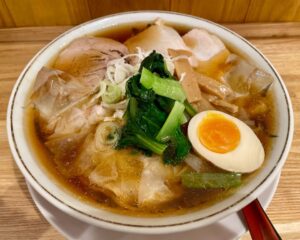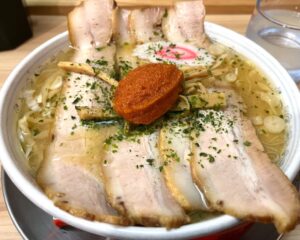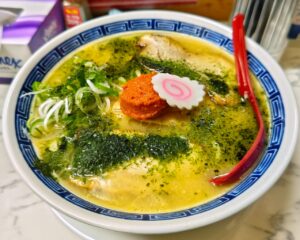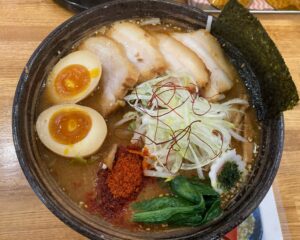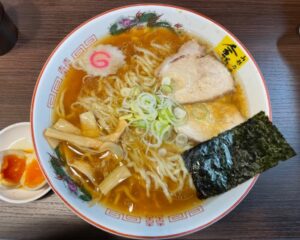Yamagata Ramen (Yamagata Pref.)
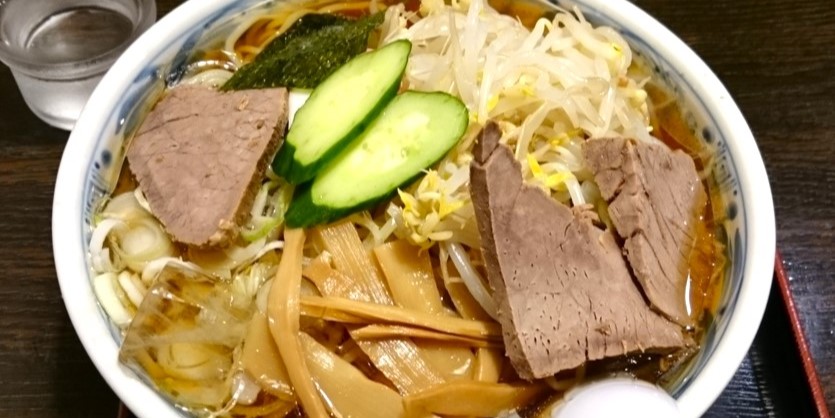
What is Yamagata Ramen(山形ラーメン)?
A general term for local ramen originating in Yamagata Prefecture.
Yamagata Prefecture has many local ramens. The areas include Sakata, Akayu, Shinjo, Yamagata, and Yonezawa, and are collectively called Yamagata Ramen.
Not just “Chilled Ramen(冷やしラーメン; Hiyashi Ramen)”
Recently, Yamagata has often been introduced as “Chilled or Cold Ramen(冷やしラーメン/冷ったいラーメン)”. Indeed, the originator of “Chilled Ramen” is Sakaeya Honten (栄屋本店 established in 1932) in Honmachi, Yamagata City. The soup is based on beef bouillon, and the chashu(sliced meat) is also beef, which is unique. And the origin of chilled wonton-
men is Sakaeya Branch(栄屋分店) in Kitayamagata.
In Yamagata Prefecture, ramen with Chinese noodles in a sweet soy sauce-based soup is often called “Chuka Soba(中華そば)”. Some people say that ramen with such soy sauce-based soup is “Yamagata Ramen”. The taste itself varies from region to region and from shop to shop within the prefecture, so it is not possible to define one menu as “Yamagata Ramen”. Many soba(buckwheat noodles) shops also serve chuka soba(ramen), and some soba shops are more popular for their ramen than their main soba, so they are sometimes categorized as “soba shop’s ramen”.
As this area is also known for its large production of Japanese beef, one of the characteristics is that there are many shops that use beef bone broth.
Why did soba shop start serving ramen in Yamagata, a soba production and consumption area?
It is said to have originated from the Great Kanto Earthquake of 1923. At that time, Yokohama Chinatown was also hit by the earthquake and many people evacuated. Many people were evacuated to Yamagata, where there were many soba shops and overseas Chinese chefs worked there. This is said to be how Chinese noodles (ramen) were introduced to soba shops in Yamagata. In other words, Yamagata had a place where Chinese food artisans could work. Yamagata Prefecture has a particularly large number of soba shops, and soba does not keep well. It is said that ramen, made with wheat that keeps well and is available all year round, was established at a good time outside of the peak season from November to March.
As for “hiyashi” (cold,chilled), Yamagata is a snowy region, but the area experiences scorching heat in the summer. This is said to have led to the “hiyashi culture” taking root. It seems that the combination of these factors is what led to chilled ramen becoming established in Yamagata.
Yamagata Prefecture also has the highest ramen consumption in Japan. (Expenses for eating out for ramen, including delivery, number one in Japan in 2022 and 2023)
Ramen consumption ranking by region in 2023 – by prefecture and major city (Ministry of Internal Affairs and Communications)
1.Yamagata Pref. Yamagata City—13,196 yen
2.Niigata Pref. Niigata City—12,573 yen
3.Miyagi Pref. Sendai City—12,480 yen
4.Tochigi Pref. Utsunomiya—City 11,352 yen
5.Akita Pref. Akita City—10,015 yen
Each region has its own characteristics, and we will introduce Yamagata ramen, which is the number one in Japan in terms of consumption, starting from roughly the north. *Chuka means Chinese noodles = ramen
[Sakata area Sakata Ramen(酒田ラーメン)]
[Shinjo area Chicken Giblets Ramen(とりもつラーメン)]
[Sagae area Meat Chuka(肉中華)]
[Tendo area Chicken Chuka(鳥中華)]
[Yamagata area Chilled Ramen(冷やしラーメン)]
[Nagai area Horse Meat Ramen(馬肉ラーメン)]
[Akayu area Spicy Miso Ramen(からみそラーメン)]
[Yonezawa area Yonezawa Ramen(米沢らーめん)]
[Others, Tsuruoka dried fish style ramen(鶴岡節系ラーメン), etc.]
[Examples of Yamagata ramen shops in the Tokyo metropolitan area]
Ramen-Japan / Examples of Ramen Shops
[Sakata area Sakata Ramen(酒田ラーメン Sakata Ramen)]
Its roots date back to a Chinese person opening a “China Soba Shop” in the late Taisho period (1920s).
The soup is based on a seafood stock made from dried sardines, flying fish, kelp, etc., and is combined with the flavor and richness of animal-based stock made from pork bones and chicken bones that have had the scum carefully removed, resulting in a refreshing yet mellow flavor and aroma.
About 80% of the noodles are made in-house, making it the best in Japan, with many high-hydration noodles. The wontons are fluffy and creamy, and the noodles are generous (200g-220g). Many of the shop names also include the character “moon(月 tsuki/getsu).”
[Examples of shops that serve Sakata Ramen]
-
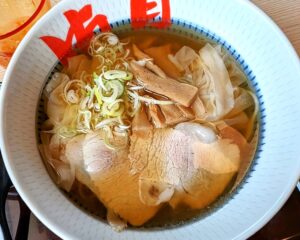
-
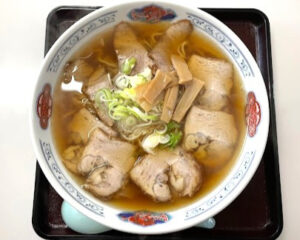
Dairaiken Kamiyasucho Branch(大来軒 上安町支店) *A long-established Sakata ramen store.
-
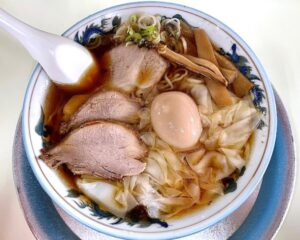
-
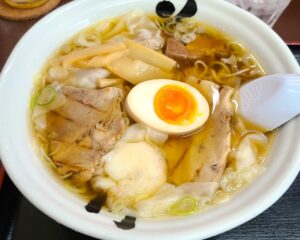
Kachoufugetsu Sakata Main Shop(花鳥風月 酒田本店) *Their meat wontons and shrimp wontons are popular.
-
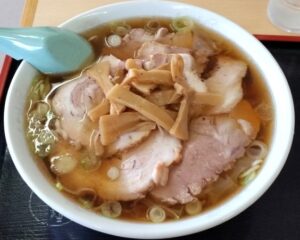
Shingetsu(新月) *Soup made from seafood stock, pork bone stock, chicken stock and vegetables.
-
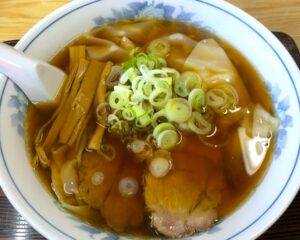
[Shinjo Area Chicken Giblets Ramen(とりもつラーメン Torimotsu Ramen)]
Shinjo(新庄) is in a mountainous area, far from the sea, and seafood was hard to come by. And on special occasions, instead of sea bream like in other areas of Japan, it was customary to butcher and cook an entire chicken and eat it. The innards, or giblets, were also a valuable source of protein and were mainly eaten in stews. The chicken parts used are called “akamots(red giblets)”, such as the heart, gizzard, and kumquat (ovaries), and have a crunchy texture.
There are Chinese noodle shops (ramen shops) that follow the tradition of soba shops, including “Iccha-an Honten Main Shop (一茶庵本店 established in 1915/now closed)”, “Iccha-an Bunten Branch Shop (一茶庵分店 now closed)”, and another “Iccha-an Shiten Branch Shop (一茶庵支店)”. In particular, the “Chicken Giblets Ramen” served at “Iccha-an Branch Shop(Shiten)” became a local specialty, and was sold under the name “Ai wo torimotsu” (a double meaning of “to arrange a match of lovers” and “chicken motsu(giblets)”) to promote the town. There is also a ramen called “Nuruma Motsu Ramen” that is only available at Iccha-an Branch, where the soup is piping hot and the noodles are rinsed with water.
[Examples of shops that serve Shinjo Torimotsu Ramen]
-
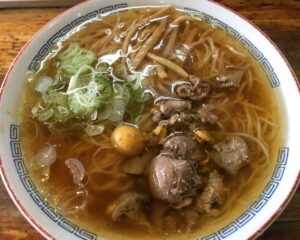
-
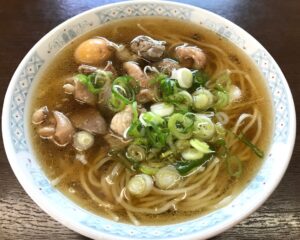
-

Umeya(梅屋) ※Plenty of noodles with plenty of soup. Includes many types of giblets.
-
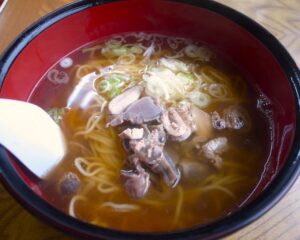
-
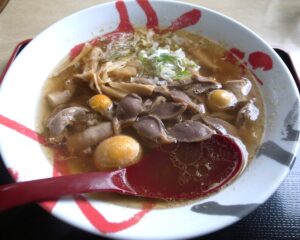
Umenosato Ramen Daikichi(梅の里ラーメン 大吉) *A popular ramen shop near ski resorts and farms.
-
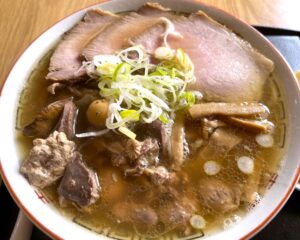
[Sagae Area Meat Chuka(肉中華 Niku Chuka)]
Originating in Kahoku Town (河北町, Kahoku District), next to Sagae, there is a type of “Chilled Meat Soba(冷たい肉そば)” that has been eaten in the nearby area for a long time. The meat mainly refers to chicken.
The one made with buckwheat flour is simply called “Meat Soba(肉そば Nikusoba),” while the one made with Chinese noodles is called “Meat Chuka(肉中華 Niku Chuka).”
The dish is characterized by the use of mature chickens in the soup stock. The only ingredients used are chewy mature chicken meat and green onions.
The people of this region have a food culture of eating chilled noodles both in summer and winter, and it can truly be called local food. Some shops use beef bone broth.
[Examples of shops serving chilled meat soba and Meat Chuka]
-
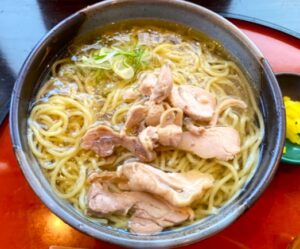
Soba Shop Hifumi(そば処ひふみ) *Basically a soba shop, but also serves ramen and udon.
-
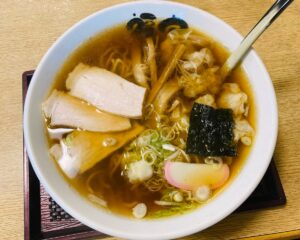
-
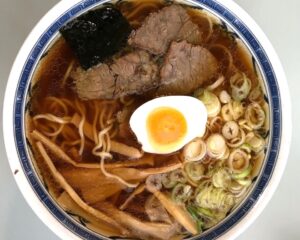
Saraya Shokudo(皿谷食堂) *A long-established shop that uses beef bone-based broth, founded in 1924.
-
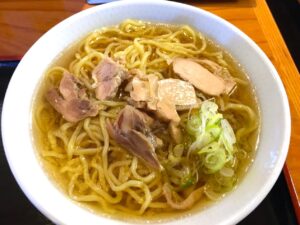
Chototei Honten(一寸亭本店) *Said to be the birthplace of chilled meat soba.
-
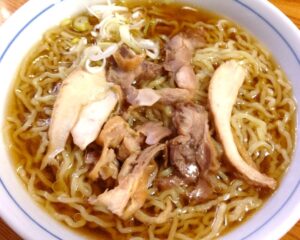
Iroha Main Shop(いろは本店) *This is also a famous shop for “chilled meat soba/meat chuka”.
-
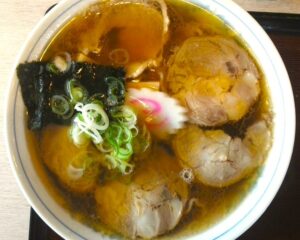
Soba Shop Katsura(そば処 かつら) *Both chilled meat soba and ramen are popular. They also sell online.
[Tendo Area Chicken Chuka(鳥中華 Tori Chuka)]
Tendo City(天童市) has long been an area where soba has been cultivated. It originated in 1861, at the end of the Edo period, when a soba shop called “Suisha Kisoba(水車生そば)” was founded. As a staff meal, they ate Chinese noodles (ramen) using the Japanese-style dashi soup used for soba and chicken. This secret menu, which was only offered to a select few people through word of mouth, became popular and was sold as a regular menu item. Other soba shop in the area followed suit and served similar Japanese-style dashi ramen, which became a specialty dish in the area. The soup is a purely Japanese light soup. It is a slightly spicy ramen topped with chicken, tempura flakes, and seaweed, and has a nice peppery flavor.
Since this dish originated in Japanese soba shop, it is often served at Japanese soba shops, and there are shops that serve it in other areas as well. It is a major menu item in Yamagata Prefecture and is a representative of Yamagata ramen.
[Examples of shops that serve Tori Chuka]
-
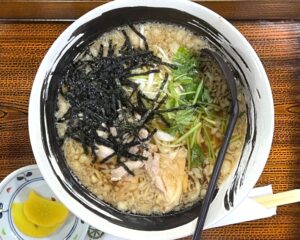
Suisha Kisoba(水車生そば) *A soba shop founded in 1861. Serves the “Original Tori Chuka(元祖 鳥中華).”
-
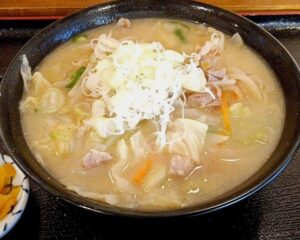
Soba Shop Ichian(そば処 一庵) *Basically a soba shop. Also serves Chinese noodles (ramen).
-
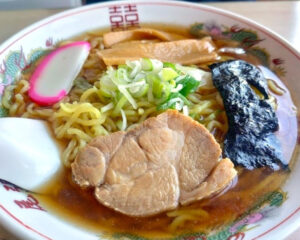
Owariya(尾張屋) *Also serves Tori Chuka and Meat Chuka using pork.
-

-
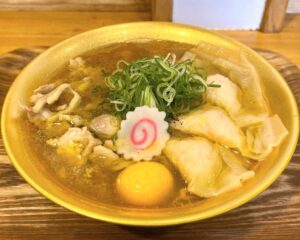
-
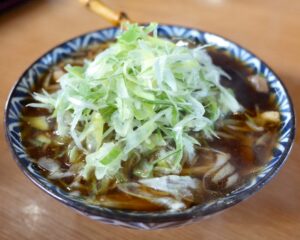
[Examples of Yamagata ramen that can be purchased at supermarkets or online]
[Yamagata Area Chilled(Cold) Ramen(冷やしラーメン Hiyashi Ramen/Tsuttai Ramen)]
The originator of chilled ramen, Sakaeya Honten, is famous. After the Second World War, a regular customer said, “Since we have chilled soba, we should have chilled ramen,” and it took a year to develop the menu. It has been on sale since 1952. It features beef soup and beef chashu.
In addition, many shops in Yamagata Prefecture, even outside of Yamagata City, generally serve chilled ramen in the summer.
[Examples of shops that serve Yamagata chilled ramen]
-
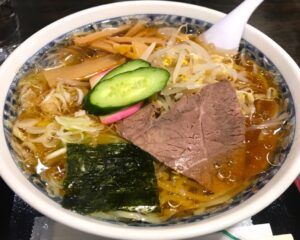
Sakaeya Honten(栄屋本店) *Established in 1932, started serving Chinese noodles in 1949.
-
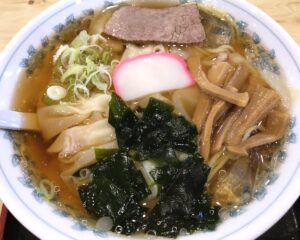
-
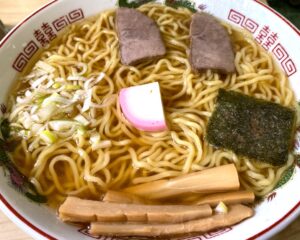
-
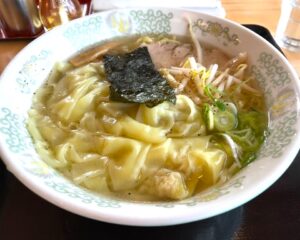
-
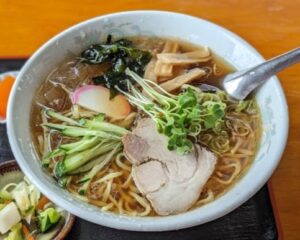
Suzukiya(すゞ木屋) *A long-established soba and ramen shop. Their chilled ramen has beef bone soup.
-

Daruma-ya Main Shop(だるまや 本店) *They also have chilled miso ramen in the summer.
[Nagai Area Horse Meat Ramen(馬肉ラーメン Baniku Ramen)]
Horse meat has been eaten since ancient times, and horse meat chashu is eaten here, which is not available in other horse meat producing areas such as Kumamoto Pref..
Horses were used as a key point for transportation along the Mogami River and the highway, and horse production was also thriving. When cultivating fields on mountain slopes, horses were more valuable than cattle, and there was also a grass racecourse.
So where did the culture of eating horse meat originate? It was Kato Kiyomasa (加藤清正 1562-1611), a Sengoku warlord famous for slaying a tiger.
When food began to run short during his invasion of Korea, Kiyomasa ate his war horses. He was given the Kumamoto domain, and horse meat production began in Kumamoto, and the horse meat culture became established in Kumamoto Prefecture. Kiyomasa’s son, Kato Tadahiro (加藤忠広 Kato Mitsuaki 加藤光秋/1601-1653), was given land in Shonai, Yamagata Prefecture, and it is said that he brought the horse meat culture of Kumamoto with him at that time. (Kato Kiyomasa’s grave is in Tsuruoka City, Yamagata Prefecture)
In other words, it is thought that the horse meat culture of Kumamoto and the active horse breeding at this transportation hub helped the horse meat culture take root in this area, and that horse meat chashu ramen was born.
[Examples of shops that serve Nagai horse meat ramen]
-
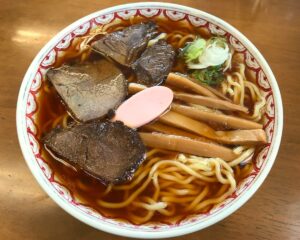
-
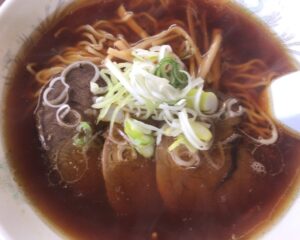
-
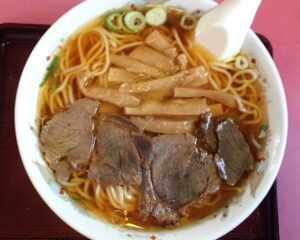
Shinraiken (新来軒 1930) *A popular shop with a wide menu. They serve horse meat and pork chashu.
-
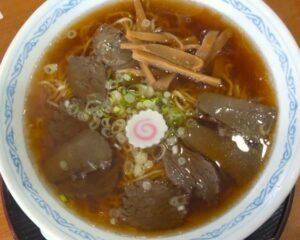
-
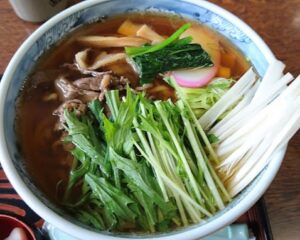
Funakoshi Ayame Soba(舟越あやめそば) ※Served under the name “Sakura Chuka”.
[Akayu Area Spicy Miso Ramen(からみそラーメン)]
Akayu Onsen in Nanyo City, Yamagata Prefecture, is a historic hot spring area that was discovered in the late Heian period (1093). While most Yamagata ramen has a soy sauce-based soup, Akayu ramen is characterized by its miso ramen topped with spicy miso(からみそ 辛味噌 karamiso).
It started when Ryu Shanghai(龍上海), founded in 1958, made miso soup with ramen soup he had brought home.
The style of topping spicy miso without mixing it into the soup was perfected in 1960.
[Examples of shops that serve Akayu Spicy Miso Ramen]
-
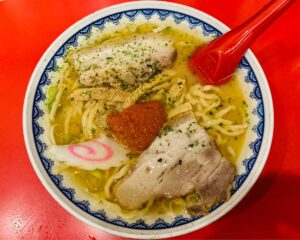
Akayu Ramen Ryu Shanghai Akayu Main Shop(龍上海 栄町支店) ※Main branch. “Akayu ramen” is soy sauce ramen.
-
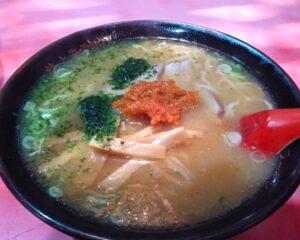
-
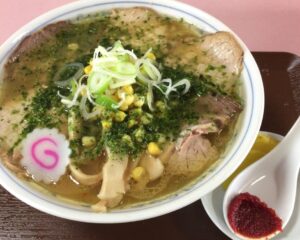
Chuka Soba Kinchan Nanyo Branch(中華そば金ちゃん南陽店) *Spicy miso is served on a spoon with miso ramen.
-
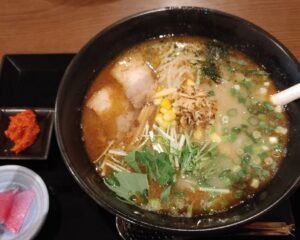
Ramen Fuku(らーめん福) *Spicy miso tsukemen and spicy miso mazesoba are also available.
-
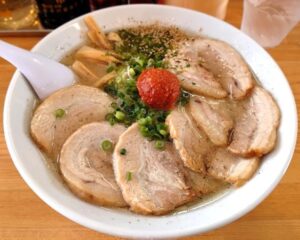
-
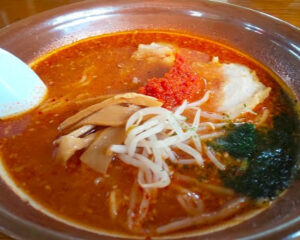
[Yonezawa Area Yonezawa Ramen(米沢らーめん)]
Yonezawa City(米沢市) is famous for Yonezawa beef, a brand of beef known as one of the three major wagyu beef brands in Japan.
Yonezawa beef, a type of wagyu beef, was introduced to Yokohama by Charles Henry Dallas, an English teacher, and became famous overnight, becoming known as the top wagyu beef in Japan.
Ramen is a very popular meal and is served in about 100 shops.
Written as “Yonezawa ramen,” it uses a light, clear soup made from chicken bones and dried sardine stock, and hand-kneaded, curly, thin noodles that are aged for 2-3 days with a lot of water. It is also called “Yonezawa’s black Chinese” because of its slightly dark color due to the unique blend of raw flour. There is ramen with the local name “Sompin Ramen(そんぴんラーメン)” with lots of seafood toppings, and “Mangiri Ramen(まんぎりラーメン)” with Yonezawa beef, a specialty of Yonezawa.
[Examples of shops that serve Yonezawa ramen(米沢らーめん)]
-

Soba no Mise Hirama(そばの店 ひらま) *Homemade noodles. Classic Yonezawa ramen.
-
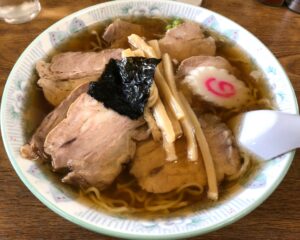
Shina Soba Kumabun(支那そば 熊文) *Their large, soft chashu pork that melts in your mouth is also popular.
-

Yamadaimae Yamatoya(山大前 やまとや) *A rare, light and oily Yonezawa ramen.
-
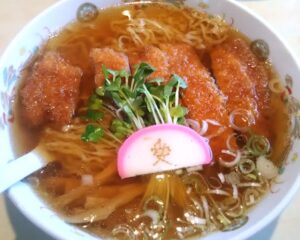
-
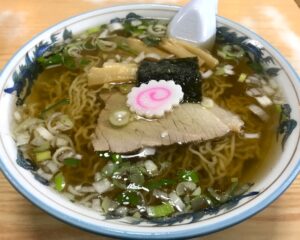
-
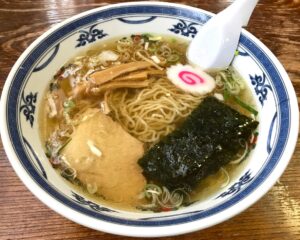
Shizumi(志づ美) *Popular Yonezawa Ramen in Takahata Town next to Yonezawa City.
[Other]
Yamagata Prefecture has its own famous ramen and ramen shops that cannot be completely categorized.
To the left of Sakata City, in the northwest of Yamagata Prefecture, in Tsuruoka City(鶴岡市), there is Konpiraso(琴平荘), a ryokan in the summer and a ramen shop in the winter. The famous shop “Kumonoito(雲ノ糸)” is also in this area. Ramen that uses shaved bonito flakes of various seafood from around Tsuruoka City is also called “Tsuruoka-bushi style ramen(鶴岡節系ラーメン)”.
In addition, squid leg tempura, “geso-ten(ゲソ天),” is a popular local food in Yamagata Prefecture, and “Uchoten(有頂天)” (Yamagata City) serves ramen topped with this. It is said that about 30 shops in the same chain and other shops serve it. “Kenchan Ramen(ケンちゃんラーメン)” (Sakata City, Yamagata City, etc.), which boasts extra thick and curly noodles, is another unique local Yamagata ramen shop.
-
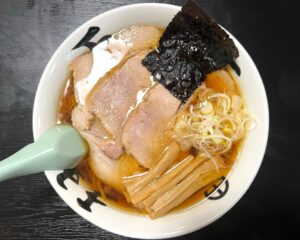
-
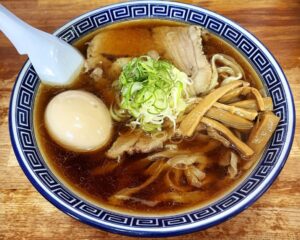
Chukasoba Kotono(中華そば 琴の) *Trained at Konpirasou and has the shop name “Koto”. Uses “wing noodles”.
-
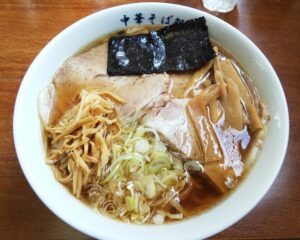
-
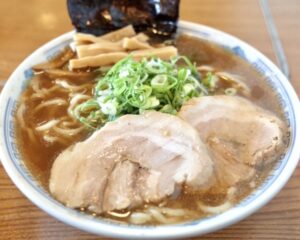
-
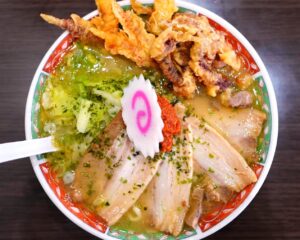
The Original Uchoten(有頂天の元祖) *The original Squid-tentacle Tempura ramen.
-
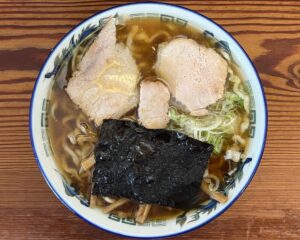
Ken-chan Ramen(ケンちゃんラーメン) *The specialty, extra thick, chewy noodles.
[Examples of Yamagata ramen shops in the Tokyo metropolitan area]
*Shop introductions and business information are current as of the time this article was written. They may be subject to change without notice.


